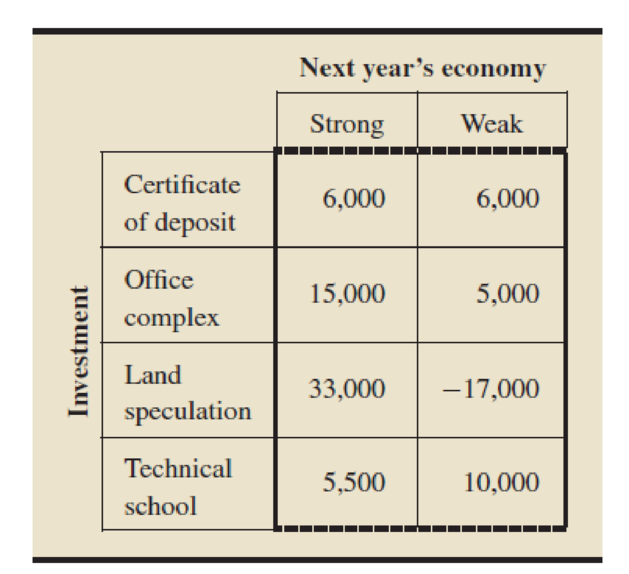
Concept explainers
Evaluating Investments. An investor plans to put $50,000 in one of four investments. The return on each investment depends on whether next year’s economy is strong or weak. The following table summarizes the possible payoffs, in dollars, for the four investments.

Let V, W, X, and Y denote the payoffs for the certificate of deposit, office complex, land speculation, and technical school, respectively. Then V, W, X, and Y are random variables. Assume that next year’s economy has a 40% chance of being strong and a 60% chance of being weak.
- a. Find the
probability distribution of each random variable V, W, X, and Y. - b. Determine the
expected value of each random variable. - c. Which investment has the best expected payoff? the worst?
- d. Which investment would you select? Explain.
Want to see the full answer?
Check out a sample textbook solution
Chapter 5 Solutions
Introductory Statistics (10th Edition)
Additional Math Textbook Solutions
Pathways To Math Literacy (looseleaf)
APPLIED STAT.IN BUS.+ECONOMICS
Introductory Statistics
A Problem Solving Approach To Mathematics For Elementary School Teachers (13th Edition)
Elementary Statistics: Picturing the World (7th Edition)
Mathematics for the Trades: A Guided Approach (11th Edition) (What's New in Trade Math)
- Consumer Preference In a population of 100,000 consumers, there are 20,000 users of Brand A, 30,000 users of Brand B, and 50,000 who use neither brand. During any month, a Brand A user has a 20 probability of switching to Brand B and a 5 of not using either brand. A Brand B user has a 15 probability of switching to Brand A and a 10 probability of not using either brand. A nonuser has a 10 probability of purchasing Brand A and a 15 probability of purchasing Brand B. How many people will be in each group a in 1 month, b in 2 months, and c in 18 months?arrow_forwardConditional probability If 40 of the population have completed college, and 85 of college graduates are registered to vote, what percent of the population are both college graduates and registered voters?arrow_forwardDividing a JackpotA game between two players consists of tossing a coin. Player A gets a point if the coin shows heads, and player B gets a point if it shows tails. The first player to get six points wins an 8,000 jackpot. As it happens, the police raid the place when player A has five points and B has three points. After everyone has calmed down, how should the jackpot be divided between the two players? In other words, what is the probability of A winning and that of B winning if the game were to continue? The French Mathematician Pascal and Fermat corresponded about this problem, and both came to the same correct calculations though by very different reasonings. Their friend Roberval disagreed with both of them. He argued that player A has probability 34 of winning, because the game can end in the four ways H, TH, TTH, TTT and in three of these, A wins. Robervals reasoning was wrong. a Continue the game from the point at which it was interrupted, using either a coin or a modeling program. Perform the experiment 80 or more times, and estimate the probability that player A wins. bCalculate the probability that player A wins. Compare with your estimate from part a.arrow_forward
 Elementary Linear Algebra (MindTap Course List)AlgebraISBN:9781305658004Author:Ron LarsonPublisher:Cengage Learning
Elementary Linear Algebra (MindTap Course List)AlgebraISBN:9781305658004Author:Ron LarsonPublisher:Cengage Learning Algebra and Trigonometry (MindTap Course List)AlgebraISBN:9781305071742Author:James Stewart, Lothar Redlin, Saleem WatsonPublisher:Cengage Learning
Algebra and Trigonometry (MindTap Course List)AlgebraISBN:9781305071742Author:James Stewart, Lothar Redlin, Saleem WatsonPublisher:Cengage Learning
 College Algebra (MindTap Course List)AlgebraISBN:9781305652231Author:R. David Gustafson, Jeff HughesPublisher:Cengage LearningAlgebra & Trigonometry with Analytic GeometryAlgebraISBN:9781133382119Author:SwokowskiPublisher:Cengage
College Algebra (MindTap Course List)AlgebraISBN:9781305652231Author:R. David Gustafson, Jeff HughesPublisher:Cengage LearningAlgebra & Trigonometry with Analytic GeometryAlgebraISBN:9781133382119Author:SwokowskiPublisher:Cengage Holt Mcdougal Larson Pre-algebra: Student Edition...AlgebraISBN:9780547587776Author:HOLT MCDOUGALPublisher:HOLT MCDOUGAL
Holt Mcdougal Larson Pre-algebra: Student Edition...AlgebraISBN:9780547587776Author:HOLT MCDOUGALPublisher:HOLT MCDOUGAL





